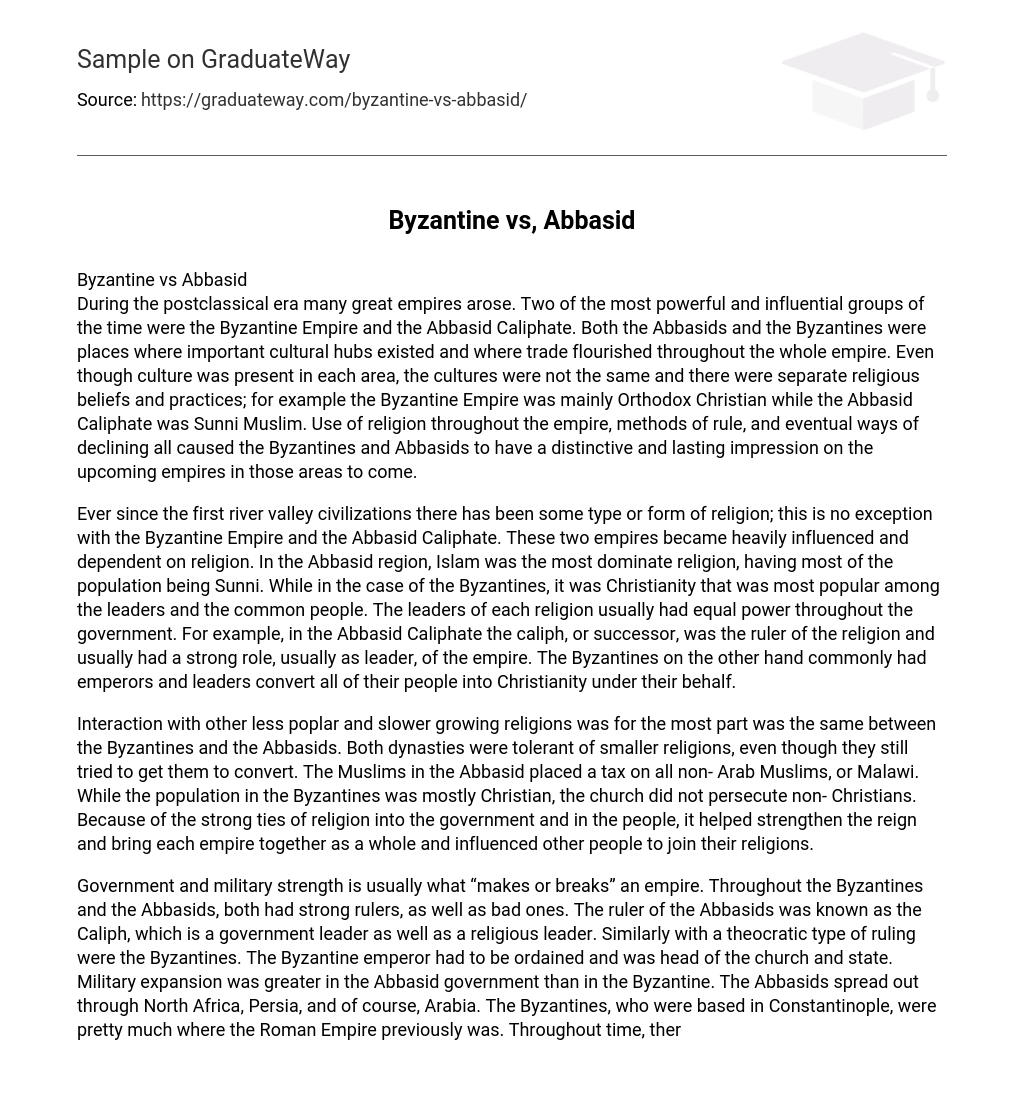The Byzantine Empire and the Abbasid Caliphate were two influential and powerful groups in the postclassical era, each with notable cultural centers and prosperous trade networks.
Both areas had culture, but there were notable distinctions in their religious beliefs and practices. The Byzantine Empire was mostly Orthodox Christian, while the Abbasid Caliphate adhered to Sunni Muslim faith. These religious influences, along with diverse governing methods and eventual decline, had a lasting effect on later empires in the region.
Religion has played a significant role in various civilizations, including early river valley societies, the Byzantine Empire, and the Abbasid Caliphate. Both empires heavily relied on and were strongly influenced by religion. The majority of people in the Abbasid region followed Islam, predominantly Sunni. In contrast, Christianity was favored by leaders and common people in the Byzantine Empire.
Both the Abbasid Caliphate and the Byzantine Empire had religious leaders who held significant power. In the Abbasid Caliphate, the caliph served as both the ruler of the religion and a leader in the empire. On the other hand, in the Byzantine Empire, emperors and leaders often required their subjects to convert to Christianity.
Both the Byzantines and the Abbasids interacted with lesser known religions in a similar way. Although they aimed to promote conversion, both dynasties showed tolerance towards smaller religions. The Abbasid Muslims imposed a tax called Malawi on non-Arab Muslims, while the majority of the Byzantine population was Christian, but non-Christians were not persecuted by the church. The integration of religion into government and society strengthened each empire’s rule and unity, prompting others to join their respective religions.
Both the Byzantines and the Abbasids had influential leaders who played a crucial role in shaping their empires’ destinies. The Caliph, ruler of the Abbasids, held power in governmental as well as religious matters. Likewise, the Byzantines adopted a theocratic governing system where the emperor served as both head of state and church. However, in terms of military expansion, the Abbasid government exceeded that of the Byzantines.
The Abbasids expanded their influence in North Africa, Persia, and Arabia, while the Byzantines, centered in Constantinople, governed the former territories of the Roman Empire. Over time, internal disputes frequently arose among the Byzantines. Both civilizations constantly launched invasions into each other’s lands. Despite coming close to victory, the Abbasids never managed to conquer Constantinople. The survival of both societies relied heavily on their formidable armies and capable leaders.
Both the Byzantine Empire and the Abbasid Caliphate faced their downfall, although the decline of the Abbasid Empire occurred earlier than that of the Byzantines. The Abbasids began to decline in the 10th century and eventually fell around 1258, while the Byzantines endured for approximately another 200 years until their decline in 1483.
Both empires experienced multiple wars, which ultimately had adverse effects on them. The Abbasids engaged in conflicts with Crusaders, Byzantines, and other external forces.
The Byzantines and the Abbasids, along with other Muslim groups like the Turks, frequently engaged in conflicts. Both empires declined due to external forces invading and conquering them. The turning point for the downfall of the Abbasids happened when the Mongols captured Baghdad. Similarly, Constantinople, now known as Istanbul, was conquered by Turkic Muslims who overthrew their rulers. The frequent fighting facilitated the overthrowing of those in power by external groups like the Mongols and Turks, ultimately leading to both the downfall of the Byzantine Empire and Abbasid Caliphate.
In the post classical era, two significant empires emerged: the Byzantine Empire and the Abbasid Caliphate. Despite their differences in religion, government structure, and eventual decline, there were several similarities between them. Both regions embraced a combination of religion and government called theocracy; however, while the Abbasid government heavily relied on its military power, this was not as prominent in the Byzantine Empire.





